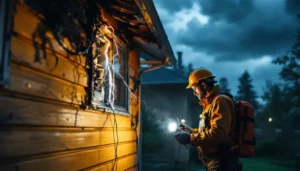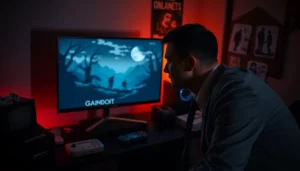Table of Contents
ToggleHorror games have a unique way of creeping into the hearts and minds of players, turning a cozy night into a spine-chilling adventure. Imagine this: you’re clutching your controller, heart racing, as you navigate through dark hallways filled with lurking terrors. It’s the perfect blend of adrenaline and entertainment, making every jump scare feel like a badge of honor.
Overview of Horror Games
Horror games captivate players by creating immersive experiences that evoke fear and adrenaline. Through dark narratives and challenging gameplay, these games draw participants into unsettling worlds.
Brief History of Horror Games
The late 1970s marked the inception of horror games, with titles like Colossal Cave Adventure introducing players to thrilling narratives. In the 1980s, Haunted House for the Atari 2600 further popularized the genre. The advent of the 1990s led to major breakthroughs, with Alone in the Dark and Resident Evil shaping modern horror gaming. These games combined atmospheric storytelling with advanced graphics, generating a fan base that endures. Over time, franchises emerged, influencing both game mechanics and audience expectations.
Evolution of Horror Game Genres
Horror games have diversified into various genres, each offering distinct experiences. Survival horror emphasizes resource management and environmental storytelling. Action horror prioritizes fast-paced gameplay and combat challenges. Psychological horror delves into mental strains and fear of the unknown, enhancing immersion. Indie horror has gained popularity, introducing innovative mechanics and unique narratives. Each genre enriches the horror landscape, appealing to a wide range of players, while maintaining core elements of suspense and terror.
Popular Horror Game Titles
Horror games captivate players with their gripping narratives and intense gameplay. These titles evoke visceral emotions, immersing players in chilling experiences.
Classic Horror Games
Classic horror games laid the foundation for the genre. Titles like Colossal Cave Adventure and Haunted House introduced players to suspense and fear in interactive formats. Alone in the Dark, released in 1992, coupled atmospheric storytelling with innovative graphics, significantly impacting the industry. Resident Evil followed, bringing survival horror to mainstream audiences in 1996. Each classic game cultivated a devoted fan base, influencing countless developers and shaping the genre’s evolution.
Modern Horror Game Releases
Modern horror games expand on classic themes, offering fresh experiences. Outlast and Amnesia: The Dark Descent emphasize psychological terror, focusing on vulnerability rather than combat. Resident Evil 7 revitalized the franchise, embracing first-person perspectives and immersive storytelling. Phasmophobia, an indie title, utilizes cooperative multiplayer to enhance the sense of fear. Such releases continue to engage audiences by blending innovative gameplay mechanics with rich narratives.
Gameplay Mechanics in Horror Games
Gameplay mechanics play a crucial role in why horror games captivate players. The combination of atmosphere, sound design, and psychological elements generates an engaging experience.
Atmosphere and Sound Design
Atmosphere significantly influences a player’s immersion in horror games. Dark environments, eerie visuals, and unexpected changes in lighting contribute to feelings of unease. Sound design enhances this atmosphere by utilizing unsettling noises, sudden sounds, and silence. These auditory elements evoke tension and alert players to lurking threats. For instance, the creaking of floorboards or distant whispers intensifies the sense of danger. Each sound serves as a cue for players to brace themselves for possible scares. Together, atmosphere and sound design create a chilling backdrop that keeps players on edge.
Psychological Elements
Psychological elements are essential in horror games, as they tap into human fears and anxieties. Many titles employ uncertainty and ambiguity to create suspense. Players often face dilemmas that challenge their decision-making, heightening tension. In psychological horror, narratives might explore themes like isolation or loss of control, which resonate deeply with audiences. Mechanics like limited resources and unpredictable enemy behavior amplify this sense of vulnerability. Players frequently question their perceptions of reality, making the experience more immersive and horrifying. This interplay between psychological elements and gameplay mechanics ensures a gripping and memorable experience.
Impact of Horror Games on Players
Horror games significantly affect players on multiple levels. They evoke intense emotional responses that resonate with participants, offering immersive experiences that often lead to lasting impressions.
Emotional Responses and Reactions
Fear, anticipation, and relief all play roles in the player’s emotional journey. Players often feel their hearts race during intense moments, heightening the experience. While navigating dark environments, those moments of jump scares trigger immediate reactions, prompting laughter alongside fear. Players often engage in communal experiences, discussing their reactions, which enhances emotional connections with fellow gamers. Empathy for in-game characters fosters deeper engagement, prompting reflection about choices and potential consequences. Such dynamics keep players on the edge, fostering a compelling psychological impact.
Community and Culture around Horror Games
The community surrounding horror games thrives on shared experiences and interactions. Gamers frequently gather online to discuss strategies and theories, bonding over the thrill and fear these games evoke. Streaming platforms have become popular venues for those wanting to share their gameplay with audiences. Here, reactions to suspenseful moments create vibrant engagement. Additionally, conventions and events celebrate horror games, cultivating a sense of belonging among fans. Ultimately, this culture enhances players’ investment, as discussions about plot twists and character development transform gaming into a social activity.
Future Trends in Horror Games
Anticipating future trends in horror games reveals exciting possibilities. This genre consistently evolves with advancements in technology and gameplay.
Technological Advances
Virtual reality already transforms immersive experiences in horror games. Players become part of unsettling environments, enhancing the fear factor. Augmented reality may expand on this, introducing chilling elements into the real world. Advanced graphics push boundaries, making visuals more realistic and heightening emotional reactions. Artificial intelligence also enhances enemy behavior, creating unpredictable and terrifying interactions. As hardware improves, developers can implement more complex narratives, further engaging players. Enhanced sound design will elevate tension, with spatial audio providing alarming cues that evoke fear.
Expected Innovations
Emerging gameplay mechanics will dampen predictability in horror games. Players might encounter adaptive storylines that change based on their choices, deepening engagement. Cooperative multiplayer modes attract players, allowing them to face fears together. Narratives could shift towards psychological horror, focusing on mind-bending experiences that challenge perceptions. Unique environments will shift, incorporating elements like procedurally generated content or dynamic weather patterns that influence gameplay. Indie’s continued rise promises inventive concepts that challenge conventions. These innovations ensure the horror genre remains fresh, captivating a new generation of players.
Horror games continue to captivate players by blending immersive storytelling with adrenaline-pumping gameplay. The genre’s evolution showcases its ability to adapt and innovate while retaining core elements that evoke fear and suspense. As technology advances the possibilities for deeper engagement and more realistic experiences expand.
The community surrounding horror games thrives on shared experiences and discussions, enhancing the emotional connections players forge with each title. With the rise of indie games and innovative mechanics the future of horror gaming looks promising. Players can anticipate fresh narratives and chilling encounters that will keep them on the edge of their seats.







